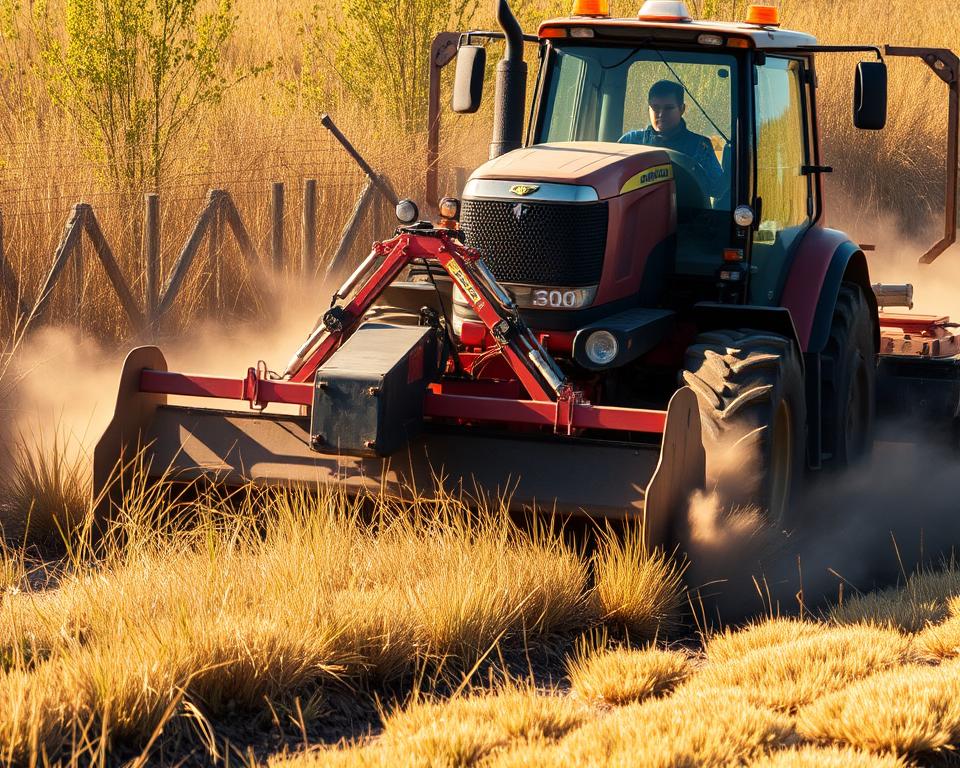Essential Guide to Land Clearing in Texas
Did you know Texas boasts over 171 million acres of land, yet much remains undeveloped? This expansive expanse of land is ripe for transformation through land clearing. As property owners strive to unlock their land’s value, understanding the intricacies of land clearing is essential. In Texas, where landscapes and land uses vary greatly, proficient land preparation is more than a job—it’s the key to unlocking profitable land development. Whether you’re embarking on a new construction, agriculture, or simply want to improve your lot, clearing services are indispensable. This guide will walk you through the fundamental steps of site clearing, guaranteeing your property reaches its full potential with streamlined land clearing and preparation strategies.
Key Highlights
- Texas has extensive land waiting to be developed.
- Land clearing is vital for turning properties into functional spaces.
- Efficient land preparation elevates land value and usability.
- Knowing the different clearing services is key for project success.
- Tree removal is a vital part of the land clearing process.
Grasping Land Clearing in Texas
Land clearing is a vital step in preparing land for construction, agriculture, or recreational use. It involves removing vegetation, debris, and obstacles. This process gives land a fresh start. Knowledge of land clearing in Texas helps property owners, developers, and farmers make better decisions for their projects.
What is Land Clearing?
Land clearing eliminates unwanted vegetation and obstacles to make land functional. It includes taking down trees and bushes, as well as removing underground obstructions like roots. This guarantees the land is ready for construction or agriculture.
Importance of Land Clearing for Development
Land clearing is essential for development. It removes hazards and enhances land access. It makes the ground level and free of obstacles, ideal for building or farming. Using professional Texas land clearing services ensures the process is done right and meets environmental standards.
Common Land Clearing Techniques
Land clearing encompasses various methods tailored for different projects and settings. Recognizing these techniques aids landowners in selecting the most suitable approach for their needs. Below, we explore mechanical clearing, manual clearing, and forestry Mulching, each with its own benefits.

Mechanical Clearing Methods
Mechanical clearing utilizes heavy machinery, like bulldozers and excavators, for rapid clearing of vast areas. It’s highly effective for commercial projects or when significant land changes are required.
Manual Clearing Techniques
Manual clearing employs hand tools for smaller areas or projects requiring careful handling. It minimizes environmental disruption, making it perfect for eco-sensitive zones. Workers use tools like saws and axes to carefully remove vegetation, offering a thorough approach.
Forestry Mulching and Its Benefits
Silvicultural Mulching offers an eco-conscious alternative for land clearing. It grinds vegetation into mulch, which improves soil quality and suppresses weeds. The mulch acts as a organic ground cover, boosting soil health and preventing erosion. This technique speeds up site preparation and reduces regrowth by disrupting root systems.
| Technique | Description | Best Use Cases |
|---|---|---|
| Mechanical Clearing | Uses heavy machinery to clear large areas quickly. | Extensive plots, commercial development. |
| Manual Removal | Involves hand tools for precision and minimal environmental impact. | Eco-sensitive zones, smaller areas. |
| Forestry Mulching | Grinds vegetation into mulch for soil enrichment. | Site preparation, erosion control. |
Steps Involved in the Land Clearing Process
Understanding the various stages in the land clearing process is essential for effective management and successful project execution. Each step contributes to achieving a ready site, allowing for safe and efficient development. Below are the critical phases involved in this process.
Site Preparation and Evaluation
The first stage of land clearing involves thorough site preparation. Evaluating the land’s condition helps identify existing obstacles that must be removed. Professionals assess tree density, brush presence, and any environmental concerns during this phase. This detailed planning is vital for outlining an effective strategy.
Tree and Brush Removal Strategies
Once site preparation is complete, teams implement various tree and brush removal strategies. Color-coding trees helps distinguish between those to keep and those to remove. Combining mechanical techniques with manual approaches ensures unwanted vegetation is removed while preserving desirable trees.
Stump Grinding and Disposal Methods
The final step involves stump grinding or complete stump removal. Professionals handle this task to ensure safety and minimize disruption to underground utilities. Stumps can be disposed of by hauling them away or, where permitted, burning on-site. Proper disposal guarantees compliance with environmental guidelines while keeping the area neat and ready for future development.
Land Clearing Costs and Budgeting
Understanding land clearing costs is vital for anyone embarking on a clearing project. Several factors affect these expenses, making budgeting crucial to avoid financial surprises. Knowing what contributes to these costs helps set realistic budgets and manage resources wisely.
Factors Influencing Land Clearing Costs
Several factors determine overall land clearing costs, including:
- Size of the Area: Larger areas with dense vegetation require more time, labor, and equipment, increasing costs.
- Type of Vegetation: Hardwoods and thick brush demand more effort and specialized machinery for removal.
- Clearing Method: Mechanical methods involve heavy equipment that can elevate costs, while manual techniques may be cheaper but labor-intensive.
- Disposal Options: Handling of cleared material—whether by burning, chipping, or hauling—adds to project expenses.
Budgeting for Land Clearing Projects
Accurate budgeting for land clearing projects is crucial. To ensure financial preparedness, individuals should:
- Estimate equipment rental and labor fees based on the chosen clearing method.
- Account for necessary permits and regulatory fees.
- Consider additional costs such as site restoration post-clearing.
- Include contingencies for unexpected challenges during the project.
Permit Requirements for Land Clearing in Texas
Understanding the rules for permits for land clearing in Texas is vital for any development project. Local laws dictate how and when land clearing can occur, focusing on environmental issues like soil erosion and habitat protection. Familiarity with these Texas regulations is essential for compliance and avoiding legal trouble.
Understanding Local Regulations
Every municipality has its own set of rules for land clearing. These laws cover methods used and environmental impact. It’s imperative to be familiar with these regulations to ensure land clearing compliance and protect local ecosystems.
Obtaining Necessary Permits
Before starting any land clearing, check if permits are required. Large-scale clearing often demands specific permissions from local authorities. Collaborating with contractors or local offices can streamline this process and ensure all regulatory requirements are met.
Choosing the Right Land Clearing Services
Finding the right land clearing services is key to a project’s success. Evaluating various aspects during contractor selection can greatly impact efficiency and outcomes. The right contractor makes the process smoother, leading to superior results.
Qualities to Look for in a Contractor
When selecting land clearing services, focus on these qualities:
- Licensing: Verify the contractor holds proper licenses for land clearing.
- Insurance: Ensure they have insurance to cover damages or accidents.
- Experience: Choose contractors with a proven track record.
- Customer Service: Clear communication and prompt responses improve the experience.
- Transparent Pricing: A reputable company provides detailed pricing to avoid surprises.
Reputation and Experience of Service Providers
Research a contractor’s reputation to gauge reliability and quality. Consider:
- Online Reviews: Check Google and Yelp for customer feedback.
- Testimonials: Look for success stories or case studies from past clients.
- Referrals: Request recommendations from trusted sources in land clearing.
- Local Understanding: Contractors familiar with local conditions better navigate regulations.
Safety Considerations in Land Clearing
Ensuring safety during land clearing operations is critical for both workers and the environment. Implementing robust safety practices creates a secure work environment and reduces risks from hazardous conditions. Workers need proper training and equipment to handle field challenges.
Safety Practices for Land Clearing Projects
Effective land clearing safety requires strict adherence to protocols, including:
- Wearing personal protective equipment (PPE) such as helmets, gloves, and goggles to shield against flying debris.
- Utilizing well-maintained machinery to mitigate accidents.
- Conducting regular safety audits and training sessions to keep teams informed of hazards.
- Establishing clear communication channels to ensure safety signals are promptly understood and acted upon.
Environmental Safety and Compliance
Integrating environmental safety into land clearing is crucial. Proper assessments help identify and minimize ecological impacts:
- Conducting pre-clearing environmental assessments to preserve wildlife and habitats.
- Adhering to local, state, and federal regulations to protect biodiversity.
- Implementing erosion control measures to prevent soil degradation.
- Utilizing sustainable practices for long-term ecological health.
Timing Your Land Clearing Project
Choosing the right time for land clearing in Texas is essential to success. Seasonal and weather factors greatly affect the project’s efficiency and outcome.
Best Seasons for Land Clearing in Texas
Winter is often the best season for land clearing in Texas. The ground is firmer, supporting heavy machinery better, and risks to local flora and fauna are minimized.
Weather Considerations Affecting Land Clearing
Wet conditions or high humidity can soften the ground, hindering equipment performance. Scheduling based on local weather patterns improves efficiency and reduces complications.
Environmental Impact of Land Clearing
The environmental impact of land clearing extends beyond vegetation removal. Key considerations include preserving habitats and preventing soil erosion, both vital for ecological balance and land integrity.
Habitat Preservation During Clearing
Selective clearing strategies reduce environmental impact by preserving wildlife habitats. Eco-friendly machinery further helps minimize disturbance and promote biodiversity.
Soil Erosion Prevention Strategies
Preventing soil erosion involves techniques such as maintaining vegetation buffers around cleared areas and installing silt fences to trap sediment. These measures support sustainable land management and preserve soil fertility.
To Conclude
Land clearing solutions are vital for successful Texas land development. Efficient land preparation maximizes property value and sets the stage for residential, commercial, or agricultural use.
Professional land clearing services ensure compliance with local laws and boost efficiency. They tackle Texas’s unique challenges with tailored approaches, promoting sustainability and environmental stewardship.
Whether you’re launching a new development or improving agricultural land, expert advice is critical. Informed land clearing decisions pave the way for thriving projects across Texas.

